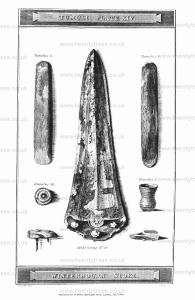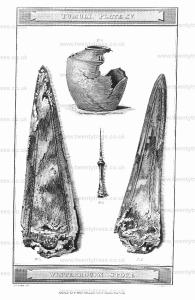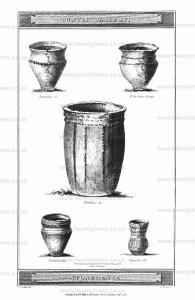Winterbourne Stoke Barrows
Winterbourne Stoke Barrows is in Station 5 Amesbury North.
To the south of the last mentioned barrow, is a large group of twenty-seven tumuli, which, being so thickly clustered, could not be numbered sufficiently distinct on the general map: I. have therefore had them engraved on a separate plate, which will explain, better than any verbal description, the different forms of the barrows which compose this group.
No. 8 [Map]. This is one of that species we have styled Druid barrows of the second In the centre it had an oval cist, four and a half feet long, and two feet class, wide, with an even floor of chalk: and in the middle of it was a heap of burned bones, but no ashes, At the distance of a foot was a fine drinking cup, richly ornamented, but unfortunately broken on removing.
No. 15 [Map]. On clearing the earth from our section in this beautiful bell-shaped tumulus, and after four days labour, we came to an interment differing from any we had yet met with; for instead of finding the burned bones of the deceased, enclosed within the native chalk, or in a sepulchral urn, we perceived they had been deposited in a box or coffin of wood, about three feet and a half long, by two feet wide, and placed upon the native turf; the whole was then covered with a coat of blueish clay, and the mound constructed. On removing the clay, and the mouldering fragments of the wood1, we first discovered small pieces of ivory, with rivets of brass through each, which I think appertained and afterwards a beautiful spear head of brass, the most co the tips of a bow; perfect and the largest we have as yet found; close to this was another lance head, which was unfortunately broken; it lay above a foot from the bones, near which was a long pin of ivory, not perforated, but neatly polished and pointed at the thinnest end; and another instrument of the same material, resembling the tweezers engraved in Tumuli Plate III. The human bones had been piled up in a heap, and intermixed with them were some rivets, and small strips of brass, which probably belonged originally to the box. In making the section of this barrow, the workmen found the remains of five or more skeletons, at a short depth beneath the surface of the sepulchral mound.
Note 1. This box was placed in a direction from north to south. The wood of which it was composed appeared be elm, yet we found also some pieces of oak.
Note 2. This fine spear-head, together with the two pieces of ivory, are engraved of their natural size in Tumili Plate XIV.

No. 16 [Map]. This, and the preceding barrow, both for superiority of size, and elegance of form, may be justly considered as the two finest tumuli in this group: they stand so contiguous to each other, that their circumvallation somewhat interfere. The first mentioned, is 89 feet in base diameter, and 14 feet in elevation: the one, now the object of our inquiry, measures in its base diameter 112 feet, and about 15 feet in elevation. On making our section, we were surprised to meet with a large and heavy piece of fossil wood, of a calcareous nature, resembling a bunch of twigs. I cannot learn that there is any substance of the kind in this neighbourhood, and I am sure the earth of which the barrow is composed, could never have generated it. At the depth of nearly 15 feet, and immediately under the spot where the fossil wood was found, we came to a shallow oblong cist, in which a skeleton had been deposited within the rude trunk of an elm-tree1, with its head lying to the north-east, On the left side of the head, a beautiful urn had been deposited, but crushed to pieces by the heavy pressure of earth upon it. We were however fortunate in collecting sufficient fragments to enable Mr. Crocker to make out an exact drawing of its and outline. (Tumuli Plate XV.) This sepulchral urn is different both in shape and colour to any we have ever found in the British sepulchres. It resembles in tint the fine red Samian pottery, and appears to have been turned in a lathe; the form of the neck is neat, and the five handles are like those we see on the Roman vessels; yet with all these appearances, we have one criterion to judge by, which, I think, will prove it ta be of British manufacture, viz. that it is not more than half baked, and the fractures discover a black and sooty appearance within, not having been burned in a kiln, like the pottery of the Romans. Near the breast of the skeleton, lay the brass dagger No. 2. which had been guarded by a case of wood, part of which appeared to have been highly ornamented, as we found a bit of wood near it that had indentations which certainly had been gilt. The handle seems to have been made of box wood, and rounded somewhat like that of a large knife, Near it lay a brass pin with an ivory handle, No. g. On the same side, but near the thigh, was a fine spear-head of brass, No, 4, very perfect, and most elegantly moulded, (for I have no doubt of these articles having been cast in moulds), and another article or ivory. The rich contents of this tumulus has induced us to crown it with royal honours, and to give it the title of KING BARROW. I have often been asked, if the largest barrows were not found, on opening, to be the most productive in their contents? The question is very natural, and I have rather wished to second that supposition; but as yet I have not a basis for that hypothesis. In the present instance, indeed, there is some ground for the above remark.
Note 1. The knots and bark adhering to the tree, we were able to ascertain with certainty its distinct species some naturalists, however, suppose, that the elm was introduced from the Continent into England. at a comparatively modern period.

No. 18 [Map], contains within its area three small tumuli, in each of which, at the depth of 18 inches, we found interments of burned bones. In the largest, which is in the centre, was a small urn, and two or three large beads of amber, in the form of half a circle and half an oval. In the second we also found two or three beads, and in the third, only burned bones.
No. 19 [Map], This tumulus measures 97 feet in diameter, and 7 feet in elevation. At the depth of nearly three feet, we discovered a sepulchral urn covering a little pile of burned bones1, and almost immediately under them, lay a skeleton; but before the workmen came to the urn, they had found two interments of burned bones in the east and west corners of their sections. At the depth of seven feet, viz. on the floor of the barrow, lay a skeleton, with its head towards the west, and near it was a small oblong cist, without any deposit in it. Amongst the earth thrown out of this barrow, we found a perforated pebble-stone, about two inches long, and very neatly polished; it has one corner broken off, and some cracks, as if it had been burned. It does not appear suited either to domestic or military purposes. The Britons seem to have attached particular qualities co certain stones; and this, probably, may have been suspended as an amulet from the neck.
Note 1. See Tumuli Plate XVI.

No. 22 [Map]. The interment which this barrow contained, presented some kind of novelty and variety. It appeared as if the native turf had been first taken off, the body placed on the chalk, and a large conical pile of flints raised over it. From finding some of the bones above the floor, and amongst the flints, we might almost be led to suppose, that the Briton here interred, had suffered a similar death to that of Achan.1 The skeleton was laid from north to south, and from the size of the bones: appeared co be that of a young person, or a female.
Note 1. And all Israel stoned him with stones and they raised over him a great heap of stones." Joshua, Chap. vii.
No. 25 [Map] is a large and rude bowl-shaped barrow, 107 feet in diameter, and 6 in elevation. Its surface being uneven, we were led to suppose it had been opened. In making a large section into it, the workmen threw out the bones of several dogs, and some of deer, and on the floor found a human skeleton, which had been originally interred from north to south, but many of the bones had been displaced, probably owing to a recent interment of burned bones, which had been deposited near the feet of this skeleton. On the right side of its head were two small earthen cups, one of which was broken; the other preserved entire; the first, though of rude materials, and scarcely half burned, was very neatly ornamented; the other, is of a singular form and pattern: it is of a yellowish colour, and perforated in several places. Near these, cups was a curious ring or bracelet of bone or ivory, stained with red, which was unfortunately broken into several pieces. With the above articles were two oblong beads made from bone, and two whetstones; one of the silicious kind, almost as fine as a hone, and neatly formed; the other, of a fine grained white silicious stone. Near the above were brass pin, a pair of petrified fossil cockle shells, a piece of stalactite, and a hard fiat stone of the pebble kind, such as we frequently find both in the towns; as well as in the tumuli of the Britons.
No. 26 [Map] is a fine bowl-shaped barrow, 97 fret in diameter, and nine feet and a half in elevation. Mr. Cunnington attempted to open it in the year 1804, but missed the interment, when, as it turned out, he was within one foot of it. Fortune now favoured our researches, and discovered to us in an oblong cist, a skeleton lying from north to south, within a shallow case of wood, of a boat-like form. Round its neck were found a great variety of amber and jet beads, a lance head, and pin of brass, with a little urn of a very neat form, which was broken to pieces.
No. 27 [Map]. This large tumulus is about 90 feet in its base diameter, and in elevation seven. has several depressions on the top, from which, and the discoveries made in it. I am inclined to think it must have been a family sepulchre. We commenced our researches by making a large section from east to west, and at the depth of two feet (though at some distance from each other), found the skeletons of two dogs, as we conjectured, but being deposited in the vegetable earth, they were much decayed. At the depth of seven feet, we came to the floor of the barrow, where we discovered a large oblong cist, five feet long, four feet wide, and two and a half feet deep, neatly cut in the chalk; and on clearing away the earth round Lhis cist, we perceived a sepulchral urn inverted in a half circle, cut in the side the large cist, which, on taking out, we found had been placed in the lap of a skeleton, which lay at the depth of about a foot within the cist, its head towards the north. The urn contained burned bones, and was of a very rude make, but from the pressure of the earth was broken in two pieces. On removing it and the skeleton, we found five more skeletons lying almost side by side; two of which were young persons; and when we reached the floor of the cist, we found, what I consider to be the primary interment, viz. two skeletons lying by the side of each other, with their heads to the north, and both extremely well preserved. One of them (from the size of the bones), was a tall and stout man; all their teeth were very firm, and remarkably even. At their head was placed a drinking cup. From the manner in which these several bodies were interred, and from the position of the urn, containing the burned bones, we had positive proof that the two different modes of burial had been practised in this barrow at different periods; also that the urn was deposited at a period subsequent to the other interments; for after interring the first bodies on the floor of the cist, the vast quantity of chalk dug out of it, was again thrown in to cover them, and this chalk would naturally rise above the level of the adjoining soil. When the other bodies were interred at a subsequent period, the vegetable mould, of which the tumulus was composed, was dug through, as also about a foot or more of the chalk out of the original cist; and after depositing the latter bodies over the original interment, the earth mixed with the chalk, would be thrown over, and being thus mixed, would make a line of distinction, being different in colour to the vegetable mould composing the tumulus and the chalk out of the cist; and this distinction was very obvious. That the urn containing the burned bones the third deposit, we have also sufficient proof, as all the earth that covered it, as well as that corner of the cist in which it stood, was vegetable mould. To the north of this group, are two very small mounds scarcely elevated above the surface, which produced nothing worthy of notice.